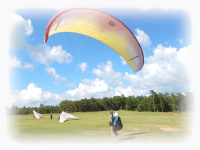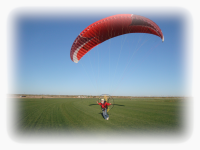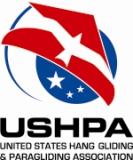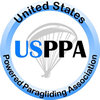Introduction to Flying Sites in the Southwest
by Had Robinson
IMPORTANT NOTICE
Launching from the steep slopes and cliffs in high desert mountains requires good kiting skills. It is hazardous to inflate and then immediately turn before stabilizing your glider overhead for a few seconds or more. Many pilots have damaged their equipment or been injured attempting to launch in the often turbulent air that characterizes the air in this region. Pilots must have the skills to kite a glider overhead under control before attempting a launch, especially in strong air. All pilots should master inflating their gliders with the A's in one hand and the C's or D's in the other. You may have to de-power your glider at any moment and this is the only way you can safely do it while attempting a launch. Pulling deep on the brakes will NOT de-power your glider! In addition, you will not have time to go searching for the correct risers if things start to go wrong and you do not have the correct ones in your hands. Jamming the brakes will only make things worse and likely send you over the back of launch at most sites.
All pilots should carefully study the weather forecasts (especially the
raw balloon data) that are available on the front page of this web site
before flying in this region. Your safety depends on it.
You can study our
introduction to southwest weather if you need help.
It is
important to note that overhead disturbances, thermal activity, and the
Jet Stream can greatly affect flying in the region. Thermals
and atmospheric disturbances can cause the Jet to mix down to the
surface and cause dangerous sheer turbulence. If you see any
gusting in the
hourly forecasts and the
Jet is
overhead, our experience is: STAY ON THE GROUND – unless you want to
rock and roll.
In general, it is best to stay on the ground if there is any gusting in
the forecasts. A solid inversion overhead, however, will protect us from what is going on above.
Here are some suggestions.
Dry Canyon
is the most consistently good site. It is a better hang gliding
than paragliding site because of the intense thermals that drift up the
canyon. The PG launch at Dry is a 15 minute hike south of the main
HG launch. The downside of Dry is that it is minimum of 40 minutes
to drive to launch.
If winds are east: We suggest Anapra. Anapra can be driven to but a guide is necessary as we have to pass through
private land to get to launch. Alternately, if you drive to the LZ out in front, you can hike up the hill and will not have to pass through private land.
If winds are southwesterly or west: Kilbourne Hole maar works well. Agave Hill is a
12 minute hike. Agave has a safer launch but does not work as
well when winds are light. Mt. Riley is workable
with winds from north to east to southwest. Southeast is best.
If the winds are weak to moderate from any direction:
Nelsons is a 40 minute hike to the top but if conditions are weak everywhere, it is a guaranteed flight with a tremendous view and the ability to
stay up until dark (even in weak conditions) because of thermals merging southwest of the peak. Always check winds aloft at 9K’ to be sure that they are under 18 mph in order to safely
launch.
We ask
that all visiting pilots donate a few bucks to the
RGSA to help them keep their sites safe and accessible. Thanks so much!
![]()




